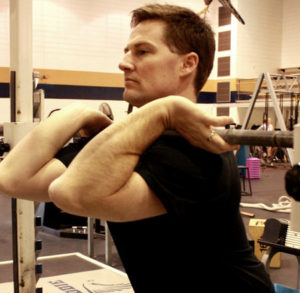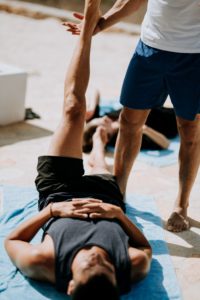 Today SevenPonds concludes our interview with William Smith, an exercise therapist and account manager at Atlantic Corporate Health, a nationally recognized health care system based in New Jersey. Educated in exercise science, today Mr. Smith works with employers, fitness professionals, and healthcare organizations to develop targeted exercise programs for various patient populations, including those suffering from or at risk for dementia and other neurocognitive disorders such as Parkinson’s disease. He is also an accomplished author, whose books include “Exercises for Better Balance,” “Exercises for Stroke,” and “Exercises for Brain Health.”
Today SevenPonds concludes our interview with William Smith, an exercise therapist and account manager at Atlantic Corporate Health, a nationally recognized health care system based in New Jersey. Educated in exercise science, today Mr. Smith works with employers, fitness professionals, and healthcare organizations to develop targeted exercise programs for various patient populations, including those suffering from or at risk for dementia and other neurocognitive disorders such as Parkinson’s disease. He is also an accomplished author, whose books include “Exercises for Better Balance,” “Exercises for Stroke,” and “Exercises for Brain Health.”
Editor’s note: This interview has been edited for length and clarity.
Kathleen Clohessy: Can we talk specifically about improving brain health now? How does exercise help keep our brains functioning at “full capacity” so to speak?
William Smith: Let me start by saying that if there’s a “silver bullet” that can help keep our bodies functioning and our minds sharp as we age, it’s exercise. Exercise not only improves blood flow and oxygen delivery to the tissues, but it can also help mitigate the damage caused by unhealthy behaviors, chemicals and inflammation.
I’ll also add to that the fact that cognitive decline and dementia are not a “normal” part of aging. Some people are predisposed to it as a result of genetics and family history. But the real culprit is cell death and the failure of the brain to make new connections when brain cells die off. That’s what neuroplasticity is about, really. Creating new connections or new neural pathways within the brain. And exercise can definitely help with that.
Kathleen: Is there a particular kind of exercise that improves brain health? Or is exercise itself the silver bullet regardless of what kind of exercise it is?
William: The type of exercise a person engages in really doesn’t matter as long as it achieves the desired effect. For a healthy adult, walking at a leisurely pace on a flat surface probably isn’t going to accomplish all that much physiologically, although it’s still better than sitting in front of the TV.
What this means is that exercise needs to be challenging to have a positive effect. I use the FITT principles from the American College of Sports Medicine to design workouts for my clients. That’s an acronym for frequency, intensity, time and type.
Kathleen: Can you expand on that a bit?
William: Sure. Let me break it down.
Frequency is how often you exercise. The ACSM recommends a minimum of 150 minutes per week for a healthy adult, which translates to about 30 minutes 5 days a week. I actually recommend more than that. I believe everyone should engage in some form of physical activity every day.

Will Smith demonstrates some exercise techniques
Intensity can be measured by heart rate or the “talk test.” For adults, a moderate intensity workout should get the heart rate up to about 100 to 110. But that varies by age and fitness level, so you might want to use the “talk test” instead. To do that, just gauge for yourself how hard it is to talk or sing while you’re exercising. If you can easily carry on a conversation, you are probably working at low to moderate intensity. If you can talk but not sing, you’re working moderately hard. If you can only gasp out a few words, you’re working hard. [Editor’s note: Check out this target heart rate chart for some guidelines on where your heart rate should be during exercise based on your age.]
Time, obviously, is how long you exercise. For aerobic exercise, that’s usually a minimum of 30 minutes. Strength training typically takes a bit longer.
Type refers to the kind of exercise you engage in. To be really effective, an exercise program should include aerobic activity such as walking, jogging or swimming; strength training; and exercises for flexibility and balance. It should also involve the three primary joints in the body: the shoulders, hips and the ankles.
Kathleen: That’s very helpful! Do you have any other lifestyle suggestions to help people maintain brain health as they age?
William: I do! Here are the top three:
#1. I already mentioned this, but it’s important, so I’ll say it again. Be consistent! Make exercise a daily habit, and engage in some kind of targeted activity every day.
#2. Limit stress. Stress leads to inflammation, which has a negative impact on brain health. That means you need to know what your triggers are and develop strategies to avoid them. For example, if you know you feel stressed (either mentally or physically) when you don’t eat well or don’t get at least 8 hours of sleep every night, take steps to eat more nutritiously and make sure you get enough rest.
#3. Create a social support system. Isolation and loneliness are big problems in our society, especially for the elderly. They can lead to depression, anxiety and cognitive decline. Join a book club. Take an exercise class. Volunteer at a local hospital. Social support is the glue that can hold us together as we age.

Working with a trained exercise therapist
can address specific symptoms
Kathleen: Those are great suggestions! Do you have any pointers for people who already have symptoms of dementia, or is your advice pretty much the same?
William: As I mentioned earlier, it’s very important to work with a qualified exercise therapist who can develop a targeted exercise program that addresses specific symptoms. For example, people with Parkinson’s disease tend to develop plantar flexion (a problem with the feet) which puts them at greater risk for falls. So I work with them on a program to mitigate that risk.
That said, anyone can benefit from a program of regular exercise, even if a short walk is all they can tolerate. Again, just do something every day!
Kathleen: Thank you so much, Will, for all the wonderful advice and for sharing your time and expertise.
William: You’re very welcome. Thanks for the opportunity!
This concludes our interview with William Smith of Atlantic Corporate Health. If you missed part one of our chat, please check back here.

 How Can Exercise Improve Brain Health?
How Can Exercise Improve Brain Health?


 Recovering Cremation Remains After the Los Angeles Fires
Recovering Cremation Remains After the Los Angeles Fires
 “As Tears Go By” by Marianne Faithfull
“As Tears Go By” by Marianne Faithfull
 “The Sea” by John Banville
“The Sea” by John Banville














